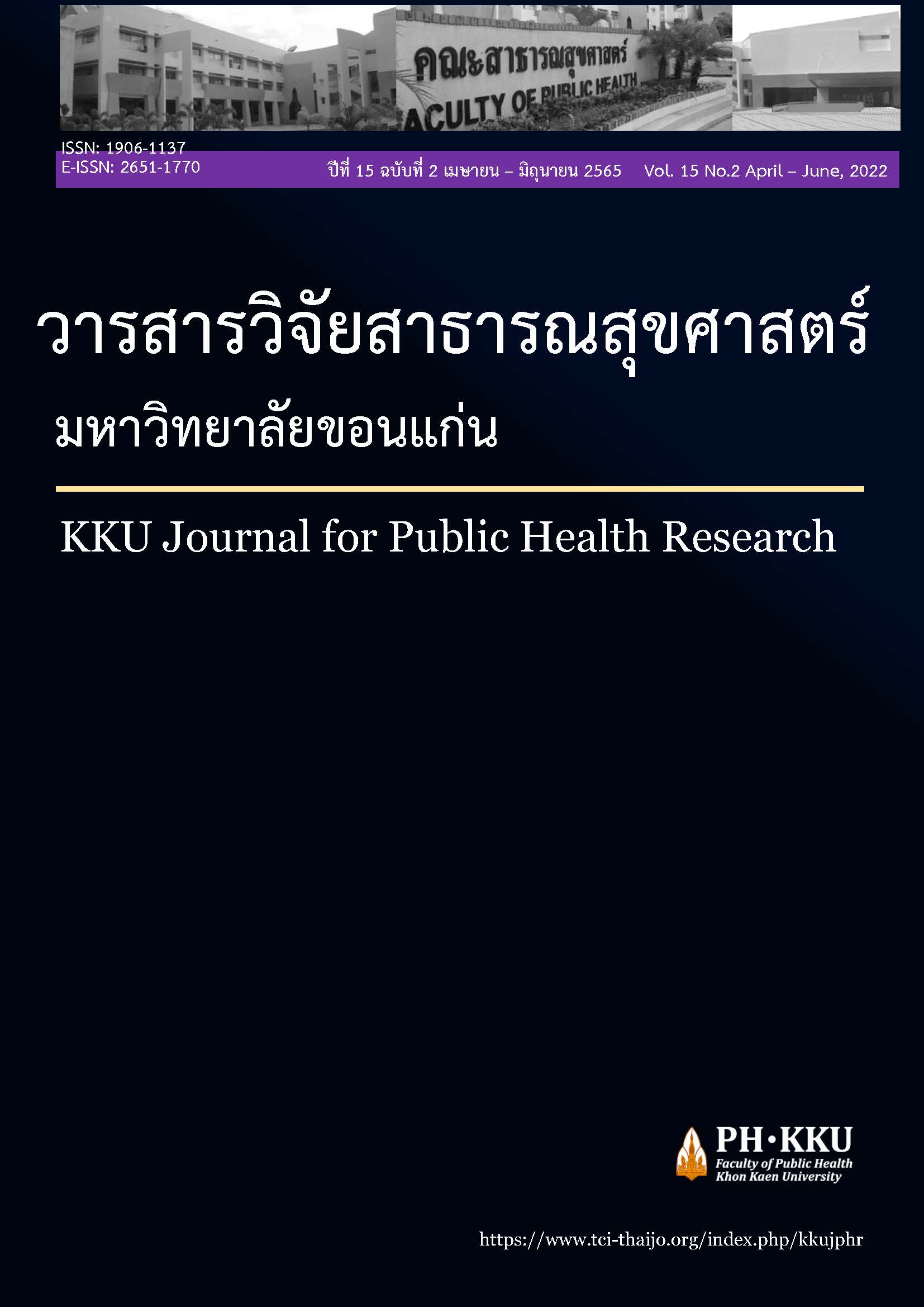การสัมผัสสารโพลีไซคลิก อะโรมาติก ไฮโดรคาร์บอน จากควันน้ำมันจากการปรุงอาหารของ ผู้ขายอาหารในโรงอาหารของโรงเรียน
คำสำคัญ:
ควันจากน้ำมันปรุงอาหาร, โพลีไซคลิก อะโรมาติก ไฮโดรคาร์บอน, 1-ไฮดรอกซีไพรีนบทคัดย่อ
การศึกษาแบบภาคตัดขวางนี้ มีวัตถุประสงค์เพื่อศึกษาการสัมผัสสารโพลีไซคลิก อะโรมาติก ไฮโดรคาร์บอน จากการสัมผัสควันจากน้ำมันปรุงอาหาร และศึกษาความสัมพันธ์ระหว่างอายุงาน ระยะเวลาทำงาน และการสัมผัสสารโพลีไซคลิก อะโรมาติก ไฮโดรคาร์บอน (PAHs) กับระดับ 1-ไฮดรอกซีไพรีน (1-OHP) ในปัสสาวะ กลุ่มตัวอย่างคือผู้ขายอาหารจำนวน 11 คน ในโรงอาหารของโรงเรียนแห่งหนึ่งในกรุงเทพมหานครฯ โดยการเก็บตัวอย่างอากาศเพื่อประเมินการรับสารโพลีไซคลิก อะโรมาติก ไฮโดรคาร์บอน และตัวอย่างปัสสาวะเพื่อตรวจระดับความเข้มข้น 1-OHP แล้ววิเคราะห์ด้วยเครื่องโครมาโตกราฟีของเหลวสมรรถนะสูงคู่กับเครื่องตรวจวัดสารแบบฟลูออเรสเซนส์ (HPLC-FLD) วิเคราะห์ข้อมูลด้วยสถิติพรรณนาประกอบด้วย ค่าเฉลี่ย ส่วนเบี่ยงเบนมาตรฐาน วิเคราะห์ความแตกต่างระหว่างความเข้มข้นของสาร1-OHP ก่อนเริ่มงานและหลังเลิกงานด้วยสถิติ Wilcoxon Matched Pairs Signed Rank Test และการวิเคราะห์สัมประสิทธิ์สหสัมพันธ์ด้วยวิธี Spearman's Rank Correlation โดยกำหนดค่านัยสำคัญทางสถิติที่ระดับ 0.05 ผลการวิจัยพบว่าความเข้มข้นเฉลี่ยของสาร PAHs เท่ากับ 39.69 ± 31.75 นาโนกรัม/ลูกบาศก์เมตร และค่าเฉลี่ยสาร 1-OHP ก่อนเริ่มงานและหลังทำงานเท่ากับ 0.60 และ 1.12 นาโนกรัมต่อมิลลิกรัมครีเอตินิน ตามลำดับ ซึ่งไม่มีความแตกต่างกันทางสถิติ และไม่พบความสัมพันธ์กันอย่างมีนัยสำคัญทางสถิติระหว่างอายุงาน ระยะเวลาทำงาน การใส่อุปกรณ์ป้องกันส่วนบุคคล (face mask) และการรับสาร
เอกสารอ้างอิง
กรมการค้าภายใน. (2564). ปริมาณการผลิต การใช้และสต็อกน้ำมันปาล์มคงเหลือ ประมวลจากการแจ้งของผู้ประกอบการ ปี2564. ค้นเมื่อ 17 พฤศจิกายน 2564, จาก http://agri.dit.go.th/index.php/department_doc/3/ปริมาณการผลิต%20การใช้และสต็อก%20น้ำมันปาล์มคงเหลือ/66
ทศพล เธียรวิภาสวงศ์. (2560). การศึกษาเปรียบเทียบกฎหมายอาชีวอนามัย และความปลอดภัยในกลุ่มแรงงานในระบบ และแรงงานนอกระบบ. สารนิพนธ์ปริญญาวิทยาศาสตรมหาบัณฑิต สาขาอาชีวอนามัยและความปลอดภัย บัณฑิตวิทยาลัย มหาวิทยาลัยมหิดล.
สถาบันวิจัยระบบสาธารณสุข. (2564). รายงานการสำรวจสุขภาพประชาชนไทยโดยการตรวจร่างกายครั้งที่ 6 พ.ศ. 2562-2563. ค้นเมื่อ 12 ธันวาคม 2564, จาก https://online.fliphtml5.com/bcbgj/znee/#p=1
สำนักงานสถิติแห่งชาติ. (2563). การสำรวจแรงงานนอกระบบ พ.ศ. 2563. ค้นเมื่อ 17 พฤศจิกายน 2564. จาก http://www.nso.go.th/sites/2014/DocLib13/ด้านสังคม/สาขาแรงงาน/Informal_work_force/2563/fullreport_63.pdf
สุนิสา ชายเกลี้ยง & ธวัชชัย ดาเชิงเขา. (2564). การประเมินความเสี่ยงทางสุขภาพต่อการสัมผัสสารโพลีไซคลิกอะโรมาติกไฮโดรคาร์บอนของ พนักงานตามตำแหน่งการทำงานในร้านอาหาร: กรณีศึกษาครัวธุรกิจสนามกอล์ฟและเขื่อน ท่องเที่ยว. วารสารพิษวิทยาไทย, 36(1), 54-73.
Agency for Toxic Substances and Disease Registry [ATSDR[. (2009). Case Studies in Environmental Medicine Toxicity of Polycyclic Aromatic Hydrocarbons (PAHs). Retrieved November 17, 2021,. from https://www.atsdr.cdc.gov/csem/pah/docs/pah.pdf
Boström, C. E., Gerde, P., Hanberg, A., Jernström, B., Johansson, C., Kyrklund, T., et al. (2002). Cancer risk assessment, indicators, and guidelines for polycyclic aromatic hydrocarbons in the ambient air. Environmental Health Perspectives, 110(Suppl 3), 451–488.
Buckley, T. J., & Lioy, P. J. (1992). An examination of the time course from human dietary exposure to polycyclic aromatic hydrocarbons to urinary elimination of 1-hydroxypyrene. British Journal of Industrial Medicine, 49(2), 113–124.
Chan, C. C., Lin, L. Y., Lai, C. H., Chuang, K. J., Wu, M. T., & Pan, C. H. (2021). Association of Particulate Matter from Cooking Oil Fumes with Heart Rate Variability and Oxidative Stress. Antioxidants, 10(8), 1323.
Hara, K., Hanaoka, T., Yamano, Y., & Itani, T. (1997). Urinary 1-hydroxypyrene levels of garbage collectors with low-level exposure to polycyclic aromatic hydrocarbons. The Science of the Total Environment, 199(1-2), 159–164.
Jongeneelen, F. J., Anzion, R. B., Scheepers, P. T., Bos, R. P., Henderson, P. T., Nijenhuis, E. H., et al. (1988). 1-Hydroxypyrene in urine as a biological indicator of exposure to polycyclic aromatic hydrocarbons in several work environments. The Annals of occupational hygiene, 32(1), 35–43.
Jongeneelen, F. J., van Leeuwen, F. E., Oosterink, S., Anzion, R. B., van der Loop, F., Bos, R. P., et al. (1990). Ambient and biological monitoring of cokeoven workers: Determinants of the internal dose of polycyclic aromatic hydrocarbons. British Journal of Industrial Medicine, 47(7), 454–461.
Klöslová, Z., Drímal, M., Balog, K., Koppová, K., & Dubajová, J. (2016). The relations between polycyclic aromatic hydrocarbons exposure and 1-OHP levels as a biomarker of the exposure. Central European Journal of Public Health, 24(4), 302–307.
Lai, C. H., Jaakkola, J. J., Chuang, C. Y., Liou, S. H., Lung, S. C., Loh, C. H., et al. (2013). Exposure to cooking oil fumes and oxidative damages: A longitudinal study in Chinese military cooks. Journal of Exposure Science & Environmental Epidemiology, 23(1), 94–100.
Lewné, M., Johannesson, S., Strandberg, B., & Bigert, C. (2017). Exposure to particles, polycyclic aromatic hydrocarbons, and nitrogen dioxide in swedish restaurant kitchen workers. Annals of Work Exposures and Health, 61(2), 152–163.
McClean, M. D., Rinehart, R. D., Ngo, L., Eisen, E. A., Kelsey, K. T., Wiencke, J. K., et al. (2004). Urinary 1-hydroxypyrene and polycyclic aromatic hydrocarbon exposure among asphalt paving workers. The Annals of Occupational Hygiene, 48(6), 565–578.
National Institute for Occupational Safety & Health (NIOSH). (1998). NIOSH Manual of Analytical Methods 5506 "POLYNUCLEAR AROMATIC HYDROCARBONS by HPLC". Search date 17 November 2021. From https://www.cdc.gov/niosh/docs/2003-154/pdfs/5506.pdf
Pan, C. H., Chan, C. C., Huang, Y. L., & Wu, K. Y. (2008). Urinary 1-hydroxypyrene and malondialdehyde in male workers in Chinese restaurants. Occupational And Environmental Medicine, 65(11), 732–735.
The International Agency for Research on Cancer. (2010). Some Non-heterocyclic Polycyclic Aromatic Hydrocarbons and Some Related Exposures. IARC Monographs on the Evaluation of Carcinogenic Risks to Humans, 92, 24-25.
VanRooij, J. G., De Roos, J. H., Bodelier-Bade, M. M., & Jongeneelen, F. J. (1993). Absorption of polycyclic aromatic hydrocarbons through human skin: differences between anatomical sites and individuals. Journal of Toxicology and Environmental Health, 38(4), 355–368.
Viau M. B. (1999). Urinary 1-hydroxypyrene as a biomarker of exposure to polycyclic aromatic hydrocarbons: Biological monitoring strategies and methodology for determining biological exposure indices for various work environments. Biomarkers, 4(3), 159–187.
ดาวน์โหลด
เผยแพร่แล้ว
รูปแบบการอ้างอิง
ฉบับ
ประเภทบทความ
สัญญาอนุญาต
ลิขสิทธิ์ (c) 2022 คณะสาธารณสุขศาสตร์ มหาวิทยาลัยขอนแก่น

อนุญาตภายใต้เงื่อนไข Creative Commons Attribution-NonCommercial-NoDerivatives 4.0 International License.



